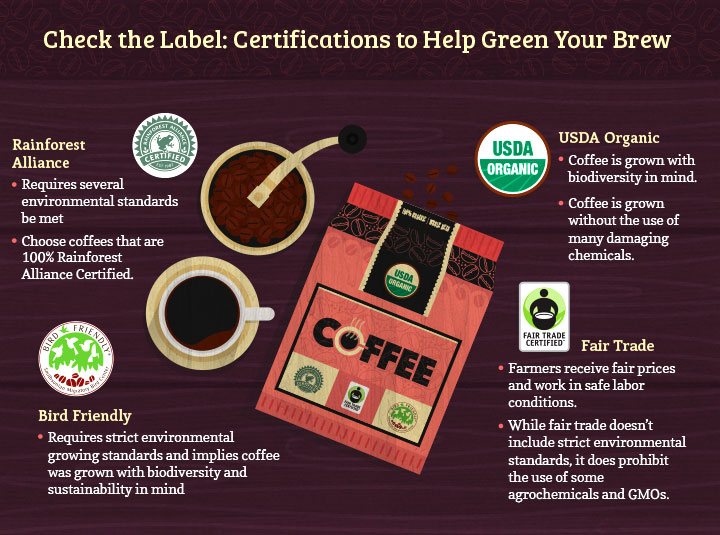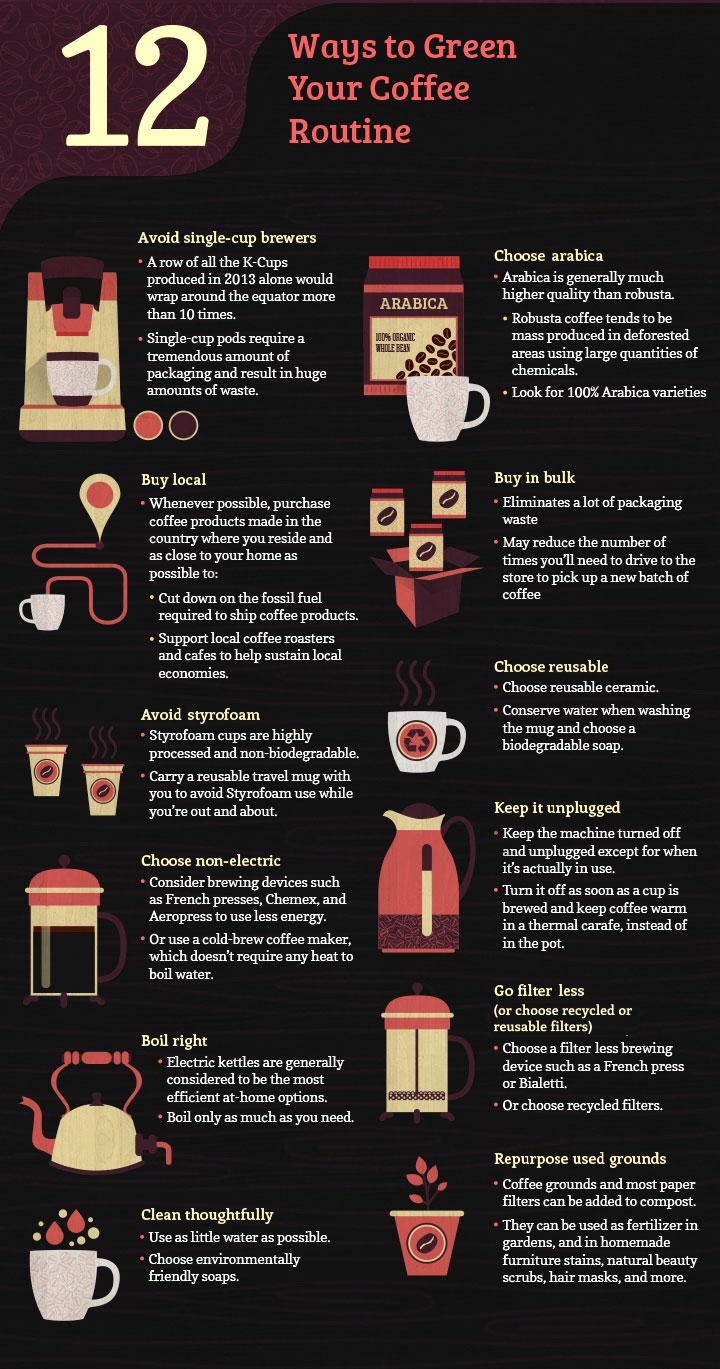Coffee is truly a global drink of choice. As a crop, coffee is grown across tens of millions of acres in more than 60 countries. In the U.S. alone, 54 percent of adults drink coffee every day, adding up to a $40 billion yearly market. The trouble is, all this international coffee consumption may not be good for the planet.
The dramatic increase in demand for coffee has created the rapid expansion of production—shifting the industry from traditional, sustainable coffee growing methods to intense monoculture models that require massive amounts of fertilizer and pesticides, decrease biodiversity, and deplete the soil.
So what’s an eco-minded coffee addict to do? The good news is there are a number of steps you can take to have your cup of coffee and green it, too.
How to Green Your Brew
Read up on certifications
When it comes to choosing environmentally friendly coffee, you may find yourself weighing the lesser of several evils—and that’s where certifications come in. Common labels include fair trade, organic, Rainforest Alliance, and bird-friendly. It can help to familiarize yourself with the many certifications that are used with coffee, and choose which factors are the highest priority for you. Here’s a quick primer:
- Fair trade certification ensures, among other things, that farmers receive fair prices and work in safe labor conditions. While fair trade doesn’t include strict environmental standards, it does prohibit the use of some agrochemicals and GMOs.
- USDA organic certification indicates that coffee is grown with biodiversity in mind and without the use of many damaging chemicals.
- Rainforest Alliance certification requires several environmental qualifications. Choose coffees that are 100 percent Rainforest Alliance certified to ensure the highest environmental standards.
- Bird-Friendly certification (by the Smithsonian Migratory Bird Center) requires strict environmental growing standards and implies coffee was grown with biodiversity and sustainability top of mind.
Avoid single-cup brewers
Single-cup brewers have grown rapidly in popularity over the past few years, making them the second most popular way to brew coffee (after traditional drip brewers) and accounting for more than $3 billion of the coffee market. Put another way, a row of all the K-Cups produced in 2013 alone would wrap around the equator more than 10 times.
Single-cup pods require a tremendous amount of packaging and result in huge amounts of waste, all of which ends up in landfills and isn’t likely to biodegrade. Even the few cups that are recyclable use an aluminum lid that must be separated from the cup before it can enter the recycling stream, making it unlikely that many of those cups actually get repurposed. And many single-serve brewers are designed to stay powered on for most of the day so the water remains warm, which is a big waste of energy.
Need one more reason to ditch the single-serve pods? Pound for pound, they’re much more expensive than the freshly ground stuff.
Choose Arabica
Two different varieties of coffee are used commercially: Arabica and robusta. Arabica is generally much higher in quality than robusta, which tends to be mass-produced in deforested areas using a large amount of chemicals. Look for 100 percent Arabica varieties to ensure both higher quality coffee and better standards for the environment.
Buy local
Whenever possible, purchase coffee products made both in the country where you reside and as close to your home as possible. You’ll cut down on the fossil fuel required to ship coffee products and help the environment in the process. Supporting local coffee roasters and cafes also helps sustain local economies.
Buy in bulk
Doing so eliminates a lot of packaging and can reduce the number of times you’ll need to drive to the store to pick up a new batch of coffee, thereby limiting fossil fuel use.
Avoid Styrofoam
Styrofoam cups are incredibly common coffee carriers, but they’re also very tough on the environment—they’re highly processed and about as non-biodegradable as a product can get. Don’t purchase Styrofoam products for your home and carry a reusable travel mug with you to avoid Styrofoam use while you’re out and about.
Choose reusable
Ceramic mugs have the benefit of being reusable—meaning your coffee habit will result in much less waste than if you used Styrofoam or paper cups. For additional eco-friendliness, be sure to conserve water when washing the mug and choose a biodegradable soap. (Bonus points if you purchase or acquire a used mug, since it won’t require any energy use for new production.) Eco-friendlier brands include We Are Happy to Serve You, I Am Not A Paper Cup, Joco cup, and Miir.
Choose non-electric
Brewing devices that don’t require electricity—including French presses, Chemex, and Aeropress—use less energy than their electric counterparts. There’s also the option to choose a cold-brew coffee maker, which doesn’t require any heat to boil water.
Keep it unplugged
If you’re still using a traditional drip brew coffee maker, keep in mind the electricity required to heat it up accounts for a large portion of its eco footprint. Reduce the impact by keeping the machine turned off and unplugged except when it’s actually in use. Turn it off as soon as a cup is brewed and keep coffee warm in a thermal carafe instead of in the pot.
Go filter-less (or choose recycled or reusable filters)
Brewing devices including the French press or Bialetti take it a bit easier on the environment by foregoing filters, which helps keep trees in the ground instead of in the coffee pot (and ultimately the landfill). Still reliant on filters? Choose recycled versions to help lessen the eco footprint. Or try CoffeeSock, a durable, organic cotton filter that can be reused daily for approximately one year. Using one cuts down on waste and on the energy (and trees) required to produce new paper filters. Plus, there’s no need to run to the store in a panic because you’ve run out.
Boil right
Even if you choose a filter-less method, brewing can still use up a lot of energy depending on the way you boil. Electric kettles are generally considered the most efficient (and therefore the eco-friendliest) option, followed by microwaves and trailed by stovetop kettles. Make sure to boil only as much as you need so you don’t waste water.
Clean thoughtfully
Regardless of which brewer you choose, there’s no way to clean your coffee brewing device without using water. Go easy on mother earth by using as little water as possible and by using environmentally friendly soaps every time you clean.
Compost
Coffee grounds and most paper filters can be added to compost along with other kitchen scraps. Composting helps ensure waste products stay out of landfills (and get put to good use).
Repurpose used grounds
Used coffee grounds can serve any number of useful purposes from fertilizer in gardens to homemade furniture stains, natural body scrubs, or hair masks. By reusing grounds, you’ll help cut down on waste as well as the need to purchase some of those products.
If you can’t ditch the coffee habit altogether, making eco-friendlier choices like those outlined above can go a long way toward greening your cup ‘o Joe. Happy sipping!








